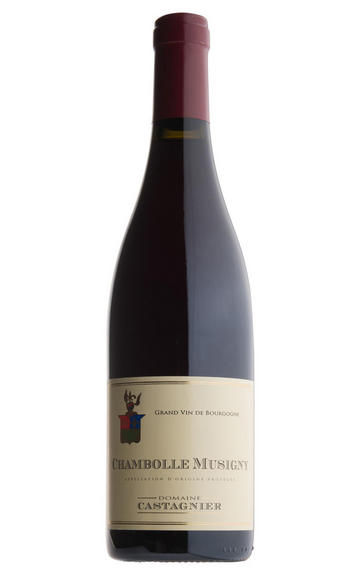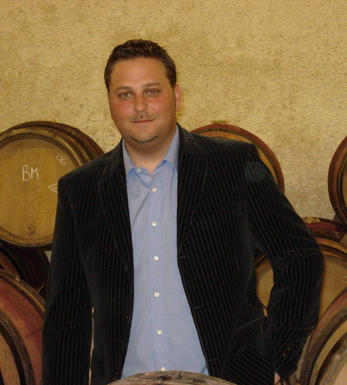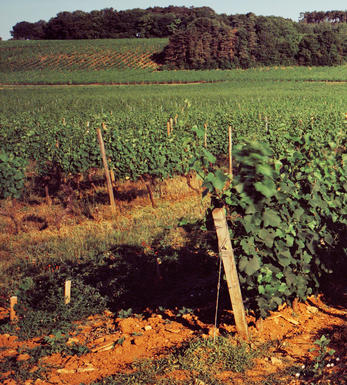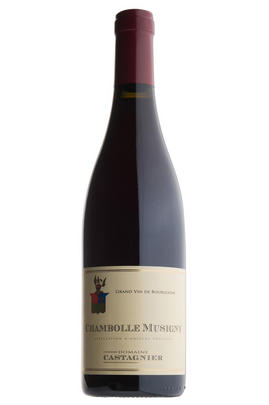
About this WINE

Domaine Castagnier
Jérôme Castagnier is fifth generation, though passage through the female line and sons-in-law has changed the family name: the originator Jules Séguin was succeeded by Albert Rameau then Gilbert Vadey, a military man, who developed the business, working closely with Alexis Lichine. Guy Castagnier, born in Algeria, married Mademoiselle Vadey and began working at the domaine in 1975. Since 2004 the wines have been bottled as Domaine Castagnier. Jérome, the sole son, did not originally intend to join the family business, becoming instead a professional trumpeter, in the Republican Guard. In 2004 he left Paris and the army and came back to Morey-St Denis.

Chambolle Musigny
Chambolle produces the most elegant wines in the Côte de Nuits, having more active chalk and less clay in the soil than the other villages. The wines may be a little lighter in colour and less tannic than Gevrey-Chambertin but they have a sublime concentration of fruit. Village Chambolle-Musigny usually provides excellent value.
Le Musigny is one of the top half-dozen vineyards in Burgundy, producing wines of extraordinary intensity and yet with a magical velvety character. Les Amoureuses is immediately appealing, a wonderfully sensual wine which deserves Grand Cru status. Bonnes Mares tends to have a firmer structure and ages very well
- 94 hectares of village Chambolle-Musigny.
- 61 hectares of Premier Cru vineyards (24 in all). The finest vineyards include Les Amoureuses, Les Charmes, Les Fuées, Les Baudes and Sentiers.
- 24 hectares of Grand Cru vineyard - Bonnes Mares and Le Musigny.
- Recommended producers: de Vogüé, Mugnier, Roumier, Barthod.
- Recommended restaurant: Le Chambolle

Pinot Noir
Pinot Noir is probably the most frustrating, and at times infuriating, wine grape in the world. However when it is successful, it can produce some of the most sublime wines known to man. This thin-skinned grape which grows in small, tight bunches performs well on well-drained, deepish limestone based subsoils as are found on Burgundy's Côte d'Or.
Pinot Noir is more susceptible than other varieties to over cropping - concentration and varietal character disappear rapidly if yields are excessive and yields as little as 25hl/ha are the norm for some climats of the Côte d`Or.
Because of the thinness of the skins, Pinot Noir wines are lighter in colour, body and tannins. However the best wines have grip, complexity and an intensity of fruit seldom found in wine from other grapes. Young Pinot Noir can smell almost sweet, redolent with freshly crushed raspberries, cherries and redcurrants. When mature, the best wines develop a sensuous, silky mouth feel with the fruit flavours deepening and gamey "sous-bois" nuances emerging.
The best examples are still found in Burgundy, although Pinot Noir`s key role in Champagne should not be forgotten. It is grown throughout the world with notable success in the Carneros and Russian River Valley districts of California, and the Martinborough and Central Otago regions of New Zealand.



Buying options
Add to wishlist
Description
This comes from the Aux Echanges vineyard, planted in 1921. A rich, deep purple colour, this has a reductive nose, with fresh crunchy fruit. This is very lively, with lovely, suave tension throughout. With rich, plump fruit, it’s a bit less reduced on the palate, showing exceptionally juicy, dark raspberries. Drink 2020-2026.
Jasper Morris MW, Wine Buyer
Jérôme Castagnier is the Guide Hachette’s Burgundian vigneron of the year for 2017 and has been shortlisted for young vigneron of the year in the region’s own awards, so it is all happening for him. He began picking his 2015s on September 9th and finished on Saturday 12th before the rain that fell later that day. This year he has used one-third whole bunches for his village wines and the Crus, and in the last two years has refined his barrel regime so that the wood has less impact on the wine. Note that the malolactic fermentation was only just finishing when we tasted and this may have impacted the bouquets.
wine at a glance
Delivery and quality guarantee